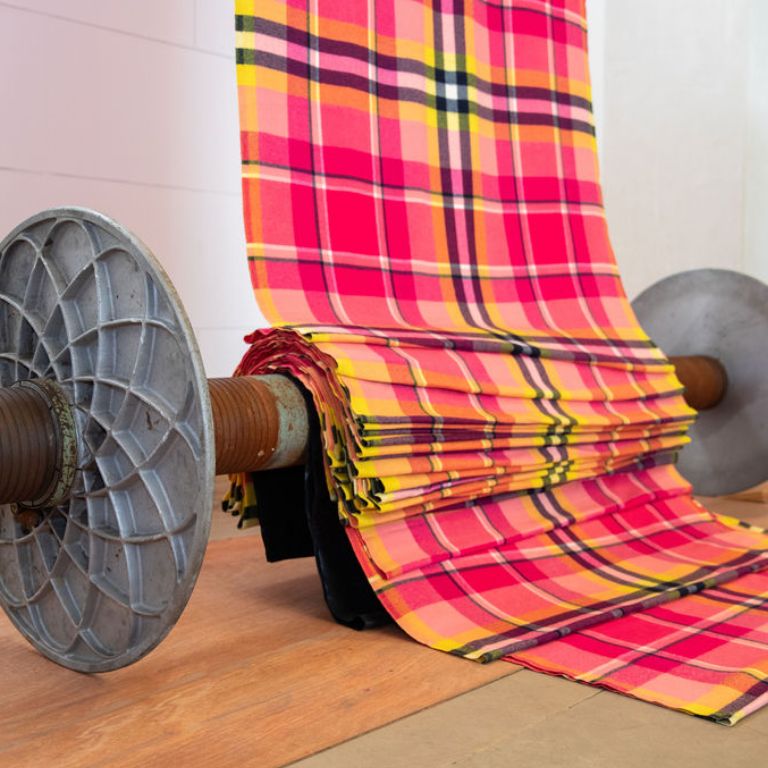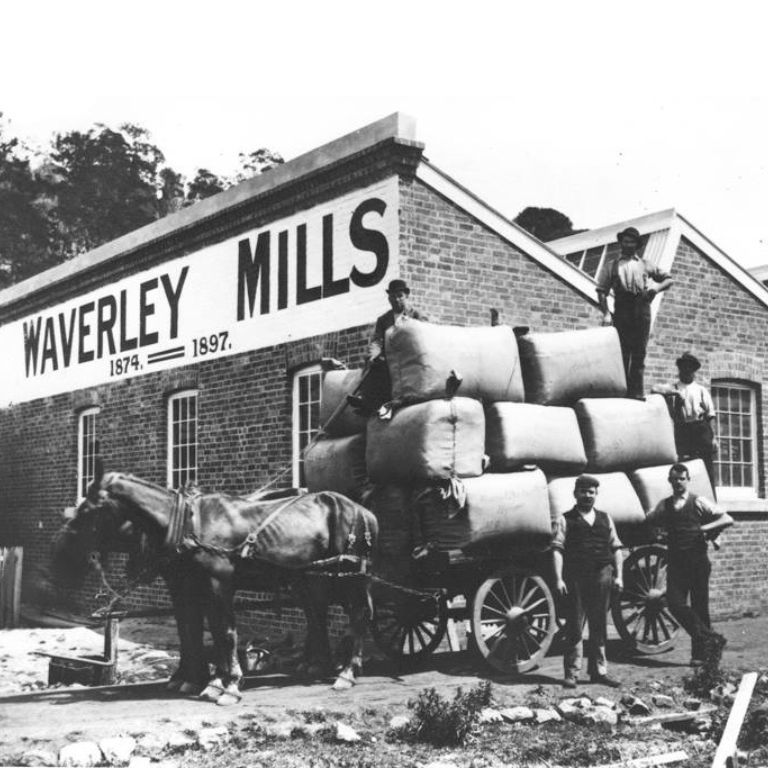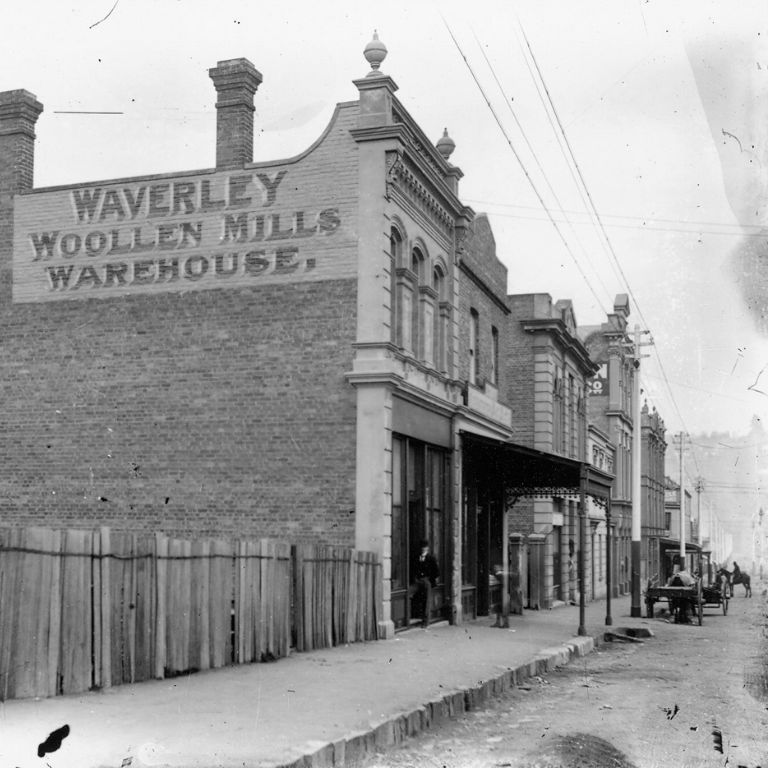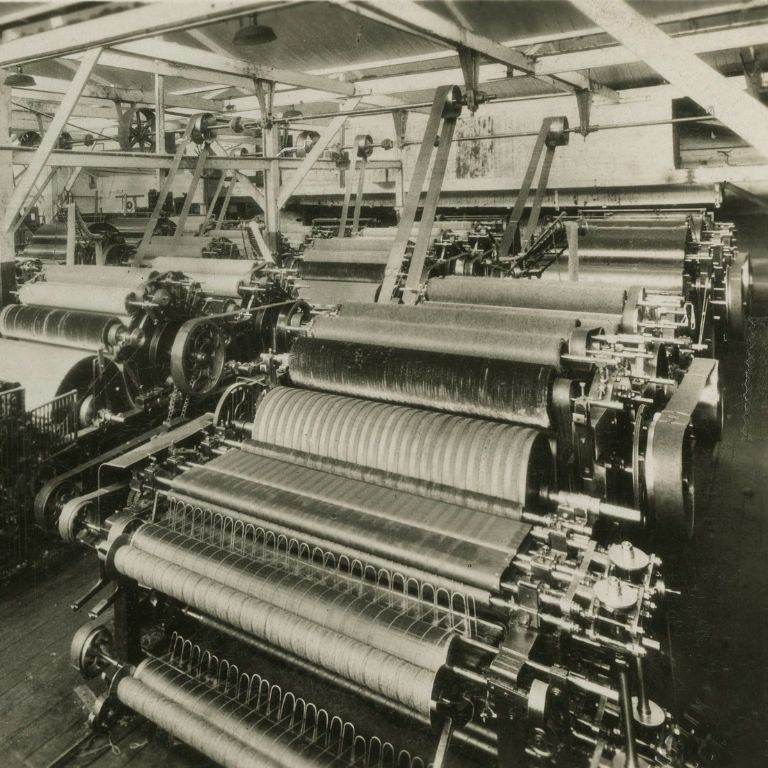Design Tasmania
Corner of Brisbane and Tamar streets
Launceston, 7250
Tasmania
info@designtasmania.com.au
+61 3 6331 5506

Waverley Mills 150+
23 March – 26 May 2024
Waverley Mills was the first commercial weaving factory of Launceston's once great textile industry and is the last remaining manufacturing facility of its kind in Australia.
With a rich history, Waverley Mills once produced 80% of the Australian blanket market and its products were used by the Australian Army, Qantas, Melbourne Airport, and other iconic Australian businesses.
Waverley Mills 150+ celebrates this legacy in an evolving exhibition, during which the public are invited to contribute to the establishment of a Waverley Mills Design Archive.
The exhibition also looks to Waverley Mills future, introducing for the first time, Tasmanian contemporary artists and designers, as an intrinsic part of its future.
The exhibition features the work of contemporary artist Tricky Walsh, and local weaver and small Palworth sheep flock owner, Sharon O’Donnell, who will be in residence at Design Tasmania every Saturday from 12-3pm, hand-weaving a design that the public is invited to help make.
If you have a special story about Waverley Mills, vintage photograph, clothing, blanket or other item, please email: hello@waverleymills.com or send a message on Facebook at https://www.facebook.com/waverleymillsaustralia

Dee Dzelalija - exhibition designer
Dee has over two decades of experience in creative leadership and design direction, with the privilege of contributing to major institutions such as the NGV, ACMI, National Gallery of Australia, State Library of Victoria, and the Tasmanian Museum and Art Gallery. Additionally, she has lent her expertise to renowned design studios including Playstreet, Southern Bureau, and Arterial Design.
Her career has been driven by an unwavering obsession with art and culture, coupled with a profound fascination for the intersection of design and critical thinking as applied to environments, exhibitions, and installations. Following an inspirational ‘gap year’ studying Furniture Design at UTAS, she moved to Melbourne/Naarm to study a Bachelor of Design (Interior/Exhibition).
She continues to specialise in Exhibition Design, channelling her energy, talent, and passion into each project. Her approach thrives in a collaborative workplace, where she draws inspiration from the collective genius.

Tricky Walsh - artist
Tricky Walsh (They/Them) is a non-binary artist working in New Norfolk, Tasmania, who works both collaboratively and in a solo capacity. Their projects focus on both spatial and communication concerns in an increasingly speculative manner and while they use a diversity of media (architecture, painting, drawing, sculpture, installation, sound, film, comics, radio) it is foremost the concept at hand that determines which form of material experimentation occurs within these broader themes.
Walsh has been awarded a Qantas Foundation Art Encouragement award and won the 2009 Hobart Art prize for their sculpture The Wasp project, has been commissioned to make works for the ICA in Richmond, VA, USA, the Museo Madre in Naples, Centre Pompidou in Paris, the Mao Jihong foundation in Chengdu, Monash University Museum of Art, the Tasmanian Museum and Art Gallery and the privately funded Detached Cultural Organisation and was included in the 2013 Mona Foma festival, organised by the Museum of Old and New Art.
Walsh has been a recipient of numerous Australia Council and Arts Tasmania grants, and has undertaken residencies in London, New York, Jogjakarta, China and Paris.
Most recently they opened the gallery Haus of Vovo in New Norfolk. A space dedicated to the enabling of artist's visions, centred around installation and spatial practices.
They are represented by MARS Gallery and have exhibited extensively throughout Tasmania, Australia and Overseas.
Tricky Walsh Fabric - Tartan
I have been interested in the making of fabric for a long time.
Not only for the machines we created to make it, but the ways in which we used it to differentiate ourselves or create a sense of community from it. Industrialisation may have made it faster, but we have been crafting fabric for almost as long as we have been traversing this planet. The oldest piece of thread was found in a cave in Georgia. Sitting there, among towering limestone formations, listening to the gradual drip of accumulation, someone made this singular part of a greater whole. It had been twisted, cut, and dyed a range of colours from a flax plant. It is doubtless that fabric has existed for a lot longer, some say a hundred thousand years or more, but it’s a nice thing to make time feel tangible. And a reminder that we have been tending to the practical needs of the body to be kept warm, but also the needs of the hands to be productive.
It was in the Palaeolithic era that we first see cave paintings of figures wearing some kind of dress or covering. The earliest sewing needles were made out of bone some 50,000 years ago. No one can quite agree on when we started to cover ourselves, but it is generally agreed that it was probably when we left Africa and started to move across the globe. It’s not surprising then, to see some variation of the loom in every culture. In the Arts et Metiers Museum in Paris there is a whole room full of weaving machines and looms. Some consist of just a few tree branches and string. In the centre of the space, a punch card jacquard loom from the 1700’s sits. A complex architecture which helped inspire the birth of the computer and has been used as a metaphor for the activity inside the human mind.
A hive of activity slowly producing solidity out of warp and weft.
It’s an interesting thing, designing something that might be worn on a body.
I jumped at the chance to design a tartan even though my tenuous connection to them, at best is through a Cornish grandfather I barely remember. There is something interesting conceptually about making a fabric which represents a people. Which displays their commonality. It’s an essence of solidarity without the nationalism, without a feeling of exclusion. When someone wears a tartan, they’re drawing attention to a lineage. Which is to draw a connection to people. Not the idea of people but people with names and habits and identities whose contributions cumulate in the one wearing the fabric.
My biological lineage is not bonded very tightly. But I have a chosen family which exist in and out of time and it is for them, these people who have contributed to this thing that I am today, whether through their kindness, their courage, their words, their art, their politics, their consideration, their attentiveness, their humour, their immoveable insistence to stand in the way of injustice, in the way of ambivalence, their pure stubborn headedness to stare life in the face and insist on more than the least. For them, my clan, I have this queer and unsubtle pattern to offer.
I look between these lines which traverse both the infinite and the defined and think of it like a tesseract of connection. A structure which does weave both time and space. Between ages, between places. Which finds us all, the strange ones who see things a little wild, and keeps us tethered somehow, at least to each other.
Tricky Walsh
March 2024

Sharon O'Donnell - artist
As a textile artist and current Honours student at the University of Tasmania in Launceston, Sharon draws inspiration from the artistry of weaving, crafting narratives that evoke a sense of warmth, connection, and tactility.
Threads spun from her own small flock of Polwarth sheep in Elizabeth Town and other local sheep farms in Tasmania, are infused throughout her creations with a deeper narrative, echoing the sustainable rhythms of the land. This interconnectedness with nature doesn't just inspire; it becomes an integral thread in the sustainability of Sharon’s artistry, weaving a narrative that aligns with the enduring spirit of both creativity and environmental stewardship.



